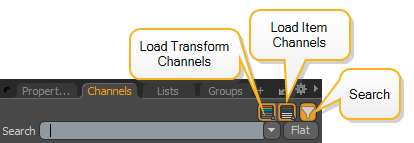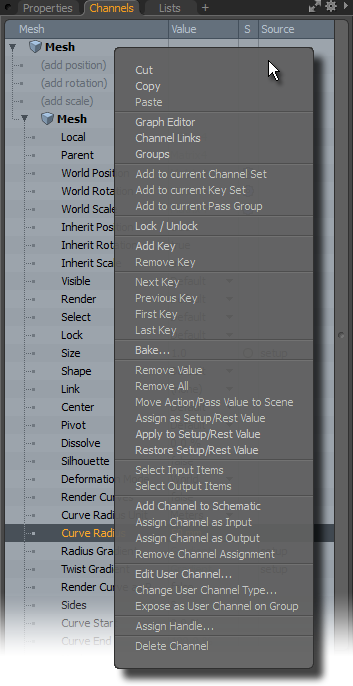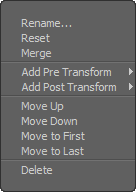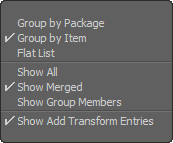Channels Viewport
The Channels viewport provides a direct method for selecting channels as well as creating, navigating, and managing any keyframes on channels. Channels are any animateable attributes of an item (identical to the attributes in the Properties Panel). You can view all channels of any item in the Channels viewport.

At the top-right of the viewport, you can find a few controls.

The Load Transform Channels ![]() button allows you to add or remove an item's transform channels (position, rotation, and scale). The Load Item Channels
button allows you to add or remove an item's transform channels (position, rotation, and scale). The Load Item Channels ![]() button adds or removes an item's non-transform channels.
button adds or removes an item's non-transform channels.
You can search the list of channels by clicking the Search ![]() button in the top-right corner of the viewport. This opens a Search field, allowing you to enter in a search string. Clicking the arrow
button in the top-right corner of the viewport. This opens a Search field, allowing you to enter in a search string. Clicking the arrow ![]() on the right of the field allows you to do a Simple Search or search for a pattern using Pattern Matching. Click Match Case to do a case-sensitive search. Click Flat on the left to only display the list of channels without the hierarchy.
on the right of the field allows you to do a Simple Search or search for a pattern using Pattern Matching. Click Match Case to do a case-sensitive search. Click Flat on the left to only display the list of channels without the hierarchy.
The Channels viewport has four columns: Channel Name, Value, Status (S), and Source. The first column displays the channel names for the currently selected item, and the second column displays the value of the channel at the current scene time. The Status (S) column shows the state of the channel (using the same dots or icons used with the channel keyframing control): animated, static, or on a keyframe. The last column displays the internal Source location of the current value. These locations are important when you define Render Passes and when using the skeleton tools to define rigs for animation.
Tip: To improve your workflow while working with User Channels, use the Channel Haul tool to toggle the visibility of all channels available for a selected item. For more information, see Displaying All Available User Channels in the 3D Viewport
Interacting with Channels
Similar to the Properties viewport, the Channels viewport updates to reflect the currently selected item — whether items are within the Item list, the Shader Tree, or even the Groups palette. Once you select an item, all the animateable attributes appear in the Channels viewport. To change an attribute's value, you click the current value in the Value column. For boolean values, clicking changes the value from True to False or vice versa. For attributes with properties, a list opens to show the possible options. For numerical values, you can click, pause, and click again to edit the value inline. Press Enter to set the value or just click elsewere than on the value.
Setting Keyframes
You can set animation keyframes by using the keyframe buttons, pressing the S key, setting in the Properties viewport, or setting within the Graph Editor. To set a keyframe for a value directly in the Channels viewport, right-click the target value and choose Add Key. You may also remove keyframes this way. When any attribute has a keyframe, colored circles appear next to the value in the S (Status) column that indicate the attribute's current state. The possible states are:![]() None- The channel is at the default value.
None- The channel is at the default value.
![]() Constant- The channel has a constant value.
Constant- The channel has a constant value.
![]() Animated- The channel has no keyframe at the current time position.
Animated- The channel has no keyframe at the current time position.
![]() Animated- The channel has a keyframe at the current time position.
Animated- The channel has a keyframe at the current time position.
![]() Mixed- The channel has differing values or states.
Mixed- The channel has differing values or states.
![]() Driven- The channel is driven by an external source.
Driven- The channel is driven by an external source.
![]() Undefined- The channel is not defined.
Undefined- The channel is not defined.
An arrow over the dot represents that channel as driving another with a channel link.
![]() Driver- The channel is linked to another.
Driver- The channel is linked to another.
A gear icon represents a channel that is being controlled by another with a channel link.
![]() Driven- The channel is linked to another.
Driven- The channel is linked to another.
You can automatically select input or output items by selecting the appropriate channel and pressing i to select the input, and o to select the output.
Right-click Menu
Right-clicking in the Channels viewport opens a menu with commands for modifying the keyframes of the various channels.

Cut: Cuts the channel values and sets them back to their defaults.
Copy: Copies the channel values.
Note: Only channel values are copied, not the properties of the channel itself, such as its lock state or any minimum/maximum range settings.
Paste: Pastes channel values. When values are pasted, the entire target channel is replaced by the source values.
Note: The above operations require the source and target channels to be compatible. Such channels are found by matching the types of the source channels to the types of the destination channels. For a channel to match it must be of the same numerical type, for example, integer or floating point, and also the same data type, such as distance, angle, or percentage. If the channel has integer hints, such as the camera Projection Type channel, then the hints must also match.
Graph Editor: Opens the Graph Editor, which represents the interpolations of keyframes (in-betweens).
Channel Links: Opens the Channels Links palette, which is useful in having one channel control another automatically. In current versions of Modo, use the Schematic View instead.
Groups: Opens the Groups viewport as a pop-up palette.
Add to current Channel Set: This command adds the selected channels to the currently active (or selected in the Groups viewport) Channel Set.
Add to Current Key Set: This command adds the selected channels to the currently active (or selected in the Groups viewport) Key Set.
Add to Current Pass Group: This command adds the selected channels to the currently active (or selected in the Groups viewport) Pass Group.
Lock/Unlock: This command toggles the edit state of the selected channel(s), as either locked, (uneditable) or unlocked (editable). Locked values are grayed out.
Add Key: Sets a keyframe at the current time with the current value.
Remove Key: Removes the keyframe at the current time.
Next Key/Previous Key/First Key/Last Key: Moves the Timeline to the appropriate time.
Bake: Bakes (or freezes) the current animation to individual keys at every frame. This is useful when exporting animations of driven items.
Remove Value: Removes all keyframes and retains the value of the initial key.
Remove All: Removes all keyframes and returns the default value.
Move Action/Pass Value to Scene: Takes the current channel value and moves it to the Scene level. This is the default base level value used when working with Render Passes.
Assign as Setup/Rest Value: Tells Modo that the values for this channel should be kept separate between Setup and Scene actions. (Only used in Setup mode.) When you edit a channel out of Setup mode, it won't affect the Setup value. (The channel has a value in Setup and a different one in the Scene action.) For example, you can use this to hide certain rig elements when animating but have them visible in Setup mode without having to toggle visibility all the time.
Apply to Setup/Rest Value: Takes the current channel value and sets it as the default Setup value. This is the resting value of an item prior to being deformed.
Restore to Setup/Rest Value: Removes the existing value for the channel and reverts it to its Setup state.
Select Input Items: Selects the driver item or channel for driven channels.
Select Output Items: Selects any items or channels being driven by the current channel for driven channels.
Add Channel to Schematic: Inserts the selected channel(s) as a schematic node into the Schematic viewport.
Assign Channel as Input/Output: You can define various User Channels for Assembly nodes, which adds them to the node's channels list. The resulting channels, once created, can be selected and defined as either inputs or outputs of the appropriate Assembly node, allowing you to connect any elements external to the Assembly.
Remove Channel Assignment: Removes any channel assigned as an input or output from the Assembly node.
Edit User Channel: Opens a dialog that allows you to modify the settings of the Users Channel, such as Name, Default Value, and the minimum and maximum values.
Change User Channel Type: Opens a dialog to change the User Channel type. The Type determines the formatting of the resulting value, such as a scalar, float, or Boolean.
Expose as User Channel on Group: When making presets for surfacing, often times the author only wants to show certain channels for you to edit, instead of giving you everything. This command allows preset creators to control which channels are exposed. By selecting specific Shader Tree item channels, the Expose as User Channel on Group command links the channels to a properly-defined User Channel on the Material Group Item where they can be edited directly (under the User Channels sub-tab). The right-click context menu for the Material Group Item allows authors to also lock the preset, making it easier to direct the preset end-user to the appropriate controls. See Preset Browser for more information on creating presets.
Assign Handle: Works in conjunction with the Channel Handles function to assign the selected channel to the appropriately created handle. See the Channel Handles page for more information.
Delete Channel: Removes the selected user channel(s) from the item.
Transform Items
Modo has a very powerful animation feature with its transform items, which are individual transform operations (such as move, rotate, and scale transforms) that control the position, orientation, and size of an item and packaged into their own container inside an associated Item. Each operation, with its three axis coordinates, is its own entity within the item it is controlling. You can add multiple transform items and change their stacking order to control the order that Modo evaluates them. This provides a flexible and powerful means of controlling and animating items. (Modo applies transforms from the bottom up.)
The primary transform's name appears in Bold in the Channels list to indicate its primary status. These are the transforms that Modo directly modifies using any Transform tools in the viewport. Modo designates the first transform created for any type as the primary transform.
You can add transform items to any item by using the various Add operations in the channels display area: Add Position, Add Rotation, and Add Scale. Once added, you can right-click the title of the transform operation to use menu commands and edit transforms in a variety of ways.

Rename: Specifies an alternate name for the selected transform item.
Reset: Resets the selected transform values to zero.
Merge: Evaluates the values of two similar, selected transform items and combines them. Modo clears the channel values for the source transform and removes it without affecting the position, orientation, or scale of the item. Modo transfers the merged values to the primary transform when it's selected, but if you've selected two auxiliary Transforms, Modo merges the values into the last item selected. This command is useful for removing zeroed transforms.
Note: Do not use the Merge command for combining transforms with animations as Modo combines the values at the current time only.
Add Pre Transform/Add Post Transform: Defines the position of the new transform item when added to the stack. Add Pre Transform adds the item below the selected transform, and Add Post Transform adds it after.
Move Up/Move Down/Move to First/Move to Last: Changes the stack location of the selected transform item. Up or Down moves the selected item one position the specified direction. First or Last moves the selected item to the bottom or top of the stack respectively.
Delete: Removes the selected transform item from the layer stack.
Right-click Menu—

Right-clicking the Channels tab opens the viewport menu. Click Viewport Settings to open the menu for the Channels viewport.
Grouping options: Define how channels are grouped in the Channel list.
Group By Package- Organizes channels by package, which are sub-groupings of related elements by individual items.
Group By Item- Organizes channels strictly by items.
Flat List- Organizes channels as a straight list with no grouping.
Show All: Shows all channels on an item. When disabled (no checkmark), Modo hides certain less-used channels (such as matrix channels).
Show Merged: Combines all the channel values for all selected items instead of listing each item's channel one after another. Useful when editing multiple items at once.
Show Group Members: Shows the members of any selected Group.
Show Add Transform Entries: Displays the Add Position/Add Rotation/Add Scale entries in the Channel list. These are shortcuts for adding additional transform channels, but for smaller monitors, you may want to remove them to save space on screen.